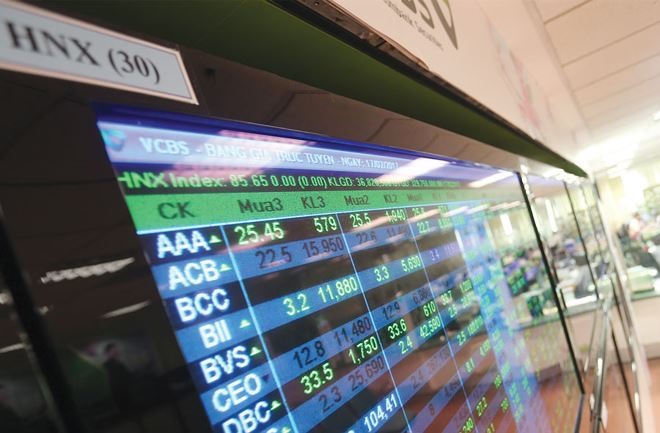 Economy
Economy

Investors are struggling to work out where to invest in the HNX30, which tracks the performance of the 30 largest stocks on the Hà Nội Stock Exchange by market capitalisation and trading liquidity.
 |
| The HNX30 Index tracks the performance of the 30 largest stocks on the Hà Nội Stock Exchange by market capitalisation and trading liquidity. — Photo tinnhanhchungkhoan.vn |
HÀ NỘI — Investors are struggling to work out where to invest in the HNX30, which tracks the performance of the 30 largest stocks on the Hà Nội Stock Exchange by market capitalisation and trading liquidity.
Launched in 2012, the HNX30 was expected to become a reference index, but after more than six years, it has not been able to escape the “shadow” of the benchmark VN30 Index.
The VN30 Index tracks the performance of the 30 largest stocks on the Ho Chi Minh Stock Exchange.
Among the 30 stocks in the HNX30 basket, few of them have attracted investors. Prices of some stocks are even hovering around just VNĐ1,000 per share. The capitalisation of these stocks is usually modest. The total market capitalisation of the stocks in the HNX30 basket as of November 21 was only VNĐ116.6 trillion, while the figure for the VN30 basket reached more than VNĐ1.89 quadrillion.
When mentioning the HNX30, investors usually think of major stocks such as Asia Commercial Joint Stock Bank (ACB), Viscostone Joint Stock Company (VCS), PetroVietnam Technical Services Corporation (PVS) and Saigon-Hanoi Commercial Joint Stock Bank (SHB). In terms of market capitalisation, ACB ranks only 27th in the market and even lower than some shares trading on the Unlisted Public Company Market (UPCoM).
Investors usually focus on liquidity, but in November, the total trading volume on the HNX30 only reached 470 million shares, equivalent to VNĐ8.1 trillion, while the figures for the VN30 basket were 1.15 billion shares, worth VNĐ41.9 trillion.
Compared to HNX30, the VN30 has much larger and more effective businesses.
In the third quarter of this year, total revenue from businesses in the VN30 basket reached nearly VNĐ238 trillion, up 16 per cent year-on-year. After-tax profit reached VNĐ27.2 trillion, up 15.5 per cent year-on-year.
Meanwhile, the total revenue of those in the HNX30 reached only VNĐ28 trillion, up 6.6 per cent over the same period last year. After-tax profit reached VNĐ3.6 trillion, equivalent to only 13 per cent of the total profit of firms in the VN30.
In Q3, 10 enterprises in the VN30 had post-tax profit of over VNĐ1 trillion, but only one in the HNX30 group did.
Total assets of the 30 businesses in the VN30 as of September 30 reached VNĐ4.2 quadrillion, 5.4 times higher than the VNĐ772.5 trillion on the HNX30.
It is clear the Hà Nội Stock Exchange needs certain adjustments to improve the quality of stocks trading on the bourse in general and those on the HNX30 basket in particular.
Nguyễn Đức Huấn, director of the HNX Trading System Department, said the HNX had been working on improving the quality of stocks trading on the bourse to attract investors. It was guiding firms to follow market regulations, standards on listing, training and information disclosure so that investors had sufficient information to make decisions before investing.
Every year, the HNX assessed the quality of firms’ information disclosure and corporate governance to encourage enterprises to improve transparency, Huấn said.
The HNX was studying new orders and new trading methods. It would collect the opinions of market players and consider the appropriate time for implementation of these methods, Huấn said. — VNS




